If you’re someone that likes to spend time outside as much as I do, then you know how important having the right gear is. As an avid fisherman, trail runner, mountain biker, rock climber, snowboarder, and all around lover of the outdoors, I have half of my basement dedicated to storing the gear I use for all of my activities. That being said, having a radio for backcountry trips never crossed my mind until I got into backcountry skiing and started hearing everyone talk about them.
There was lots of hype around the Rocky Talkie, so I decided to give it a try and there’s a solid chance I’m never going to leave the house without one again. Having one hanging off of my pack has not only made me feel safer while going out on adventures, but it’s also made the experience of everything from fishing to backcountry skiing more enjoyable. Plus, they’re made by an awesome group of people that share similar passions to mine.
Quick Navigation:
About Rocky Talkie | About The Radios | Our Review | Summary
Our Testing
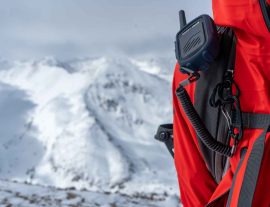
Rocky Talkie on summit of Mount Elbert, Colorado
Testing was done in all types of terrain, activities, and weather in both Colorado and Utah. From backcountry skiing, to hiking, to fly fishing. They will also soon be used for climbing trips.
Update: We are now 4 years into our heavy Rocky Talkie usage. We own more of them…not because any stopped working, just to give to our friends during big adventures. This article was co-written and edited by Max DesMarais, also a constant user of Rocky Talkies.
Rocky Talkie has a new add on to there setup, a Waterproof Hand Mic, which adds tons of versatility and allows the radio to be safely stored in a pack. This is an awesome addition to the Rocky Talkie package.
Where To Purchase
You can purchase Rocky Talkies and other items on their website: Rocky Talkie or on Amazon (currently unavailable).
About Rocky Talkie
Rocky Talkie was started in 2019, by two friends in Denver, Colorado after they had tested several other radios and decided that none were rugged enough for adventures in the backcountry. Rocky Talkie was a passion project for Bryce Jones and Alex Page who designed the radios in Bryce’s apartment in Denver and tested them in the Colorado backcountry. They set out to create radios that not only allowed users to stay connected in complicated terrain, but were also easy to use, had a long battery life, and could stand up to the harshest elements. In addition to designing a great product, Bryce and Alex also want to give back, so for every radio sold, they donate $2 to search and rescue teams. Check out this quick video to learn a bit more about their mission and passion for communication in the outdoors.
The Rocky Talkie & What Sets It Apart
The Rocky Talkie is a 2-watt backcountry radio that doesn’t require a license to operate. 2-watts is the strongest a radio can be without obtaining a license (making it the exact power radio needed for the vast majority of adventurers). This power allows users to get ranges up 25 miles if they are in line of sight, 1 to 5 miles in mountainous terrain, and around half a mile in rolling hills and dense forests. If you’re interested in learning more about how terrain affects the range of these radios, check out the video that Rocky Talkie put together. It’s informative, but quick and easy to digest.
Outside of the maximum possible power for an everyday adventurer, there are two things that set the Rocky Talkie apart, battery life and the attachment system. I’ll go into both in a bit more detail later, but the main stats are a 3+ day battery life in -20 degree weather and an attachment system that has two points to secure the radio to you, ensuring that you don’t drop it no matter the intensity of your activity. Want to pick up a Rocky Talkie? Click here. They cost $95 each, but the default option is to sell them in a pair, so make sure you select the correct number of radios you’d like to buy.
Activities They’re Great For
-
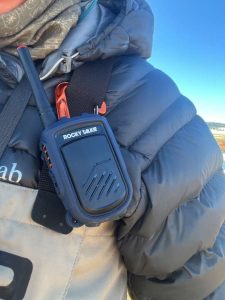
Rocky Talkie strapped to waders while fly fishing in Colorado
When I first got these radios, I thought I would only use them for backcountry skiing. Radioing partners when they rounded corners, rode over rollers, or when the group separated on the skin track due to different fitness levels made sense to me. What I didn’t think of was that these radios would be great for almost any outdoor activity. After taking them skiing several times and being amazed by their range and battery life (I took them on 4 adventures before having to charge them), my best friend and I decided to take them fishing with us. We spend a lot of time walk and wade fishing and are always in search of the best holes, so we often separate and catch up as we move up or downstream. With the Rocky Talkies, it felt like we were fishing right next to each other even though we were sometimes half a mile apart fishing. We could let each other know if we hooked a big one and needed help netting or if there was a bigger and better hole that we could both fish together. The Rocky Talkies have changed how we fish for the better.
Since I had such a great experience taking the Rocky Talkies fishing, I’ve also taken them resort skiing, hiking, and am looking forward to taking them multi-pitch climbing as the weather warms up. Easy and clear communication with my backcountry partners while separated was something I had never thought of, but is now something I won’t take for granted. I feel safer in the backcountry knowing that my partners are just a push of a button away and that if something were to happen to any of us, we would be able to easily communicate in a rescue scenario.
Technical Specs
| Radio Service | FRS (no license required) |
| Channels | 128 |
| Range | Line-of-sight: 25+ miles Mountains: 1 to 5 miles Forest/Hills: 0.5 to 3 miles City: Up to 1 mile |
| Power | 2 Watt |
| Extra Features | Privacy Codes, Channel Lock, High/Low Power Modes, Scan Mode, Roger Beep |
| Waterproofing | IP56 (Splashproof/Snowproof, not submergible) |
| Dimensions | 16.2 x 5.9 x 2.7 cm |
| Weight | Radio Only: 4.8 oz, Full System: 7.9 oz |
Free Shipping
Free standard shipping is available for all U.S. orders.
Returns & Warranty
Rocky Talkie has a 30 day 100% satisfaction guarantee that you can read about here.
Our Review
Performance, Range, & Battery Life

On this day, the air temperature was -15 F, and we had zero issues with transmission or battery life.
These radios perform very well in every condition I’ve tested them in so far. By far the most rigorous testing I’ve done was while climbing and skiing Mt. Elbert, Colorado’s highest peak. Despite having blue skies for the ascent, the temps were in the 20s and the wind was blowing around 30 mph. After a 9 hour day hanging on the outside of my pack in the freezing cold, I only lost about 20% of the total battery. Throughout the day, I never lost signal with my partner, even when he was over half a mile ahead of me on a ridge out of line of sight while I was struggling to get grip on the ice with my splitboard. The wind made it a bit difficult to hear him at times, but as long as I turned my body to block the wind a bit, my transmissions would come through fine on his end. Plus, even with the whipping wind, the speakers on the Rocky Talkie were loud enough that I could hear him clearly. The best part was that I didn’t have to worry about all of the blowing snow because the Rocky Talkie is IP56 splashproof and snowproof so as long as you don’t submerge it in water, it will keep on transmitting.
I haven’t specifically tested the range of the Rocky Talkie, but in every situation I’ve used it in so far, the audio quality has been stellar. I haven’t encountered any static even being well over a mile away from my partners and outside of line of sight. I’m confident that in 90% of scenarios in the backcountry I will be able to hear my partners and for the other 10%, we’ll be able to predict loss of signal and will be able to plan accordingly.
Ease of Use
Setting up the Rocky Talkie was as simple as it gets. Inside the box there’s the radio, a charging cable, and a quick setup guide for the radio. All you have to do is turn it on, slide the channel lock switch off, and choose the same channel as your partners, then you’re all set. Before you start your activity, I would recommend sliding the channel lock switch back to the lock position, just to make sure you don’t accidentally switch channels while you’re out in the backcountry, but otherwise after the initial setup you should be good to go. The radio had a 70% charge right out of the box, so I didn’t even need to charge it until I had finished 4 different adventures. The best part is, the radio will be at the same level of charge as when you turned it off, so you don’t have to worry about losing charge while it sits idle. Just remember to turn it off when you get back to the car after your adventure.
Durability
Our 3 year old Rocky Talkies have the same long battery life, the same performance, and just a few extra scratches. All in all, these are holding up extremely well to being beaten, battered, thrown, rained on, frozen, and thawed.
Functionally, Look, & Feel
One of the things I was worried about when I got the Rocky Talkie was that it would swing all over the place and bounce around while I was skiing. I was pleasantly surprised when I opened the box and realized that they had thought of that already. The carabiner that holds the radio onto your bag is secured to the radio with a very thick almost rubber like material that keeps the carabiner from sliding around. This makes skiing with the radio clipped to the straps of your backpack very simple, so you can quickly communicate with your partners. Plus, the radios also feature a secondary strap so you can unclip the radio, talk to your partners, and not worry about dropping it. Lastly, the button to transmit via the radio is very easy to press and doesn’t get accidentally pressed when you bump into things or ski really aggressively which makes it easy to communicate when you want to and silent when you don’t.
While incredibly functional, the Rocky Talkie also looks very sleek. They have a simple design with a screen that flashes your battery percentage when you turn it on and shows you which channel you’re currently set to. They also have an orange Mammut carabiner that stands out against the other minimalist design features and makes the radio stand out when handing off of your backpack, fishing pack, or climbing rack.
Overall Rating – 5/5
All in all, I have nothing negative to say about the Rocky Talkie. It’s got a long battery life, great range, impressive design, durability, and it even looks cool. It allows me to stay in constant communication with my backcountry partners in an effortless way and makes me feel safer when I’m in the backcountry. I would recommend this radio to anyone who lives a rugged lifestyle outside and engages in any activity where separation from their partner is essential to success. The Rocky Talkie has delivered in every scenario I’ve tested it in so far and I have faith it will continue to do so for a long time in the future. It’s now a staple item on my backcountry packing checklist.
Additional Photos
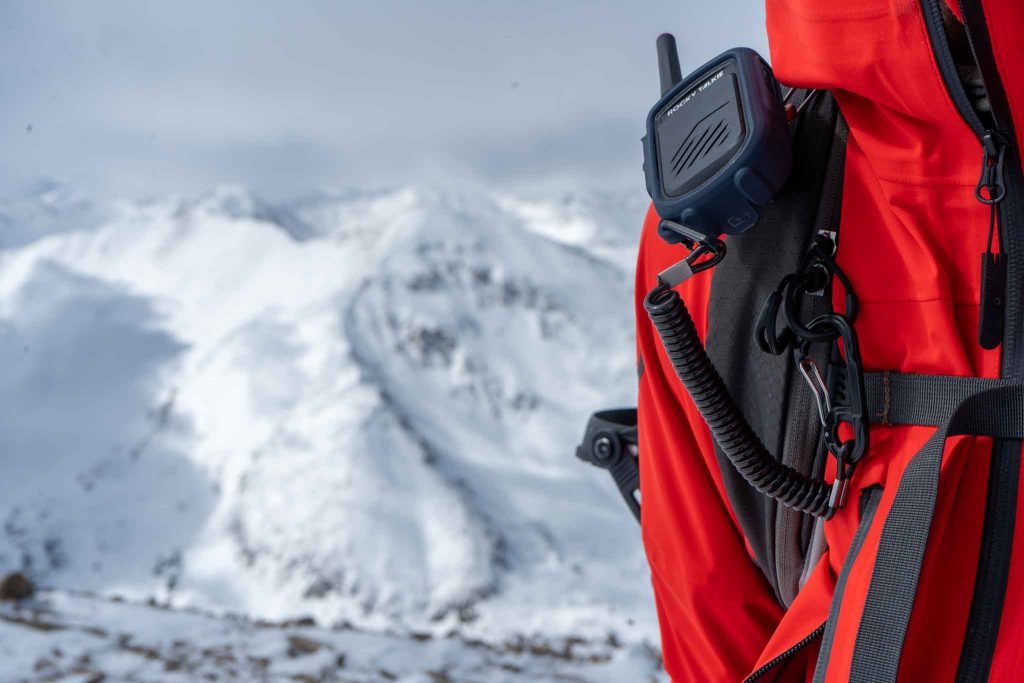
Rocky Talkie on summit of Mount Elbert, Colorado
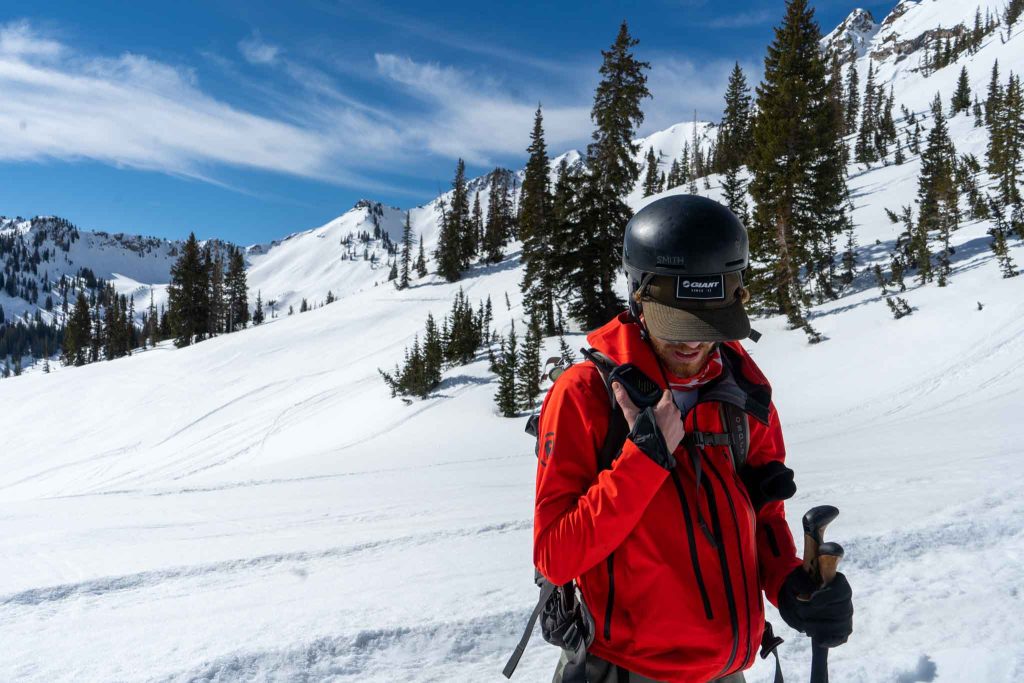
Backcountry skiing in Utah with Rocky Talkie
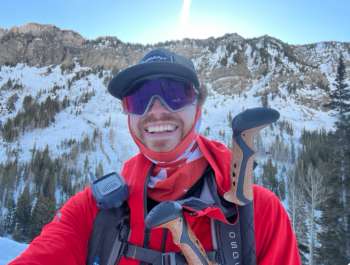
Paul Brastrom is an active outdoorsman from Houston, Texas. He recently completed his goal of climbing all of the Colorado 14ers and is continuing to spend his time in the Colorado Rockies. A digital marketer during the week and a mountain biker, splitboarder, rock climber, hiker, runner, and fly fisher when he’s not a work, Paul is at home in the mountains.

